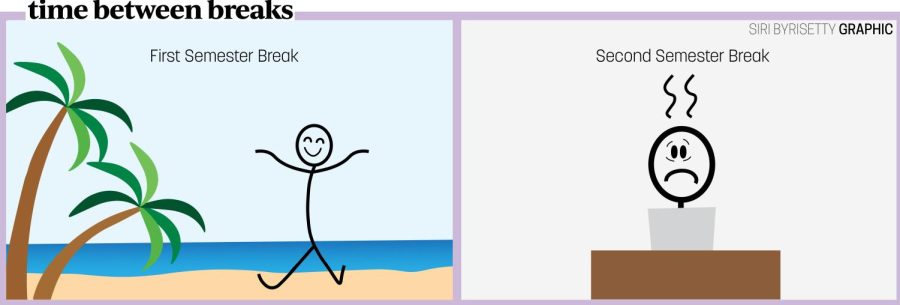If there were three words we could use to describe the feeling of second semester, it would be over-kneaded bread dough. To make bread, you need to mix flour, water and yeast, but you can’t mix it for too long. Otherwise, the dough becomes tough and hard to stretch, ultimately producing a dry and hard bread that crumbles. The solution? You have to let the dough rest and rest for a long enough time.
 Rest is not only important for bread dough, but it’s also important for humans. The American Psychological Association suggests the need for breaks and vacations to reduce stress, reduce the risk of heart disease and improve productivity. However, for this school, we only have a day of break in each of the months of January, February and March. One day is not enough. According to a study published in the Journal of Happiness Studies, the optimum length for a break is eight days, which gives people just enough time to unwind after a period of stressful work and let go of their responsibilities.
Rest is not only important for bread dough, but it’s also important for humans. The American Psychological Association suggests the need for breaks and vacations to reduce stress, reduce the risk of heart disease and improve productivity. However, for this school, we only have a day of break in each of the months of January, February and March. One day is not enough. According to a study published in the Journal of Happiness Studies, the optimum length for a break is eight days, which gives people just enough time to unwind after a period of stressful work and let go of their responsibilities.
We and other students are under a great deal of pressure during the second semester. The pace of classes seems to accelerate. There seems to be an endless amount of homework to be done each night. While there is that one-day break in between winter and spring break, we don’t use that day to rest. We use it to catch up on work—work that leads us to break under pressure like the gluten strands do in overworked bread dough. Outside of schoolwork, we have other responsibilities and sources of stress: participating in extracurricular activities, working a job, taking the SAT or ACT, researching or visiting colleges, applying for summer programs, taking care of siblings and the list goes on. The fact that winter and spring breaks are four months apart is a problem that cannot be overlooked.
To alleviate the stress on students, the school should consider moving spring break, which takes place from March 31 to April 7 this year, to mid-March. This shortens the time between winter break and spring break, allowing students to rest more frequently and preventing burnout. In fact, many schools around the country have their break in March. For example, Purdue University and Indiana University have their spring break the week of March 13. Having the break in March also gives AP teachers adequate time to review for AP exams in May whereas our current spring break only leaves three weeks of time to review, worsened by the fact that we often forget what we just learned after a week of break trying to relax.
Ultimately, we hope the school will consider reducing the time between breaks to lessen the amount of stress and pressure on students during the second semester. Only then will we feel more motivated, productive and relieved. After all, bread dough only rises if it rests.































![What happened to theater etiquette? [opinion]](https://hilite.org/wp-content/uploads/2025/04/Entertainment-Perspective-Cover-1200x471.jpg)













































![Review: “The Immortal Soul Salvage Yard:” A criminally underrated poetry collection [MUSE]](https://hilite.org/wp-content/uploads/2025/03/71cju6TvqmL._AC_UF10001000_QL80_.jpg)
![Review: "Dog Man" is Unapologetically Chaotic [MUSE]](https://hilite.org/wp-content/uploads/2025/03/dogman-1200x700.jpg)
![Review: "Ne Zha 2": The WeChat family reunion I didn’t know I needed [MUSE]](https://hilite.org/wp-content/uploads/2025/03/unnamed-4.png)
![Review in Print: Maripaz Villar brings a delightfully unique style to the world of WEBTOON [MUSE]](https://hilite.org/wp-content/uploads/2023/12/maripazcover-1200x960.jpg)
![Review: “The Sword of Kaigen” is a masterpiece [MUSE]](https://hilite.org/wp-content/uploads/2023/11/Screenshot-2023-11-26-201051.png)
![Review: Gateron Oil Kings, great linear switches, okay price [MUSE]](https://hilite.org/wp-content/uploads/2023/11/Screenshot-2023-11-26-200553.png)
![Review: “A Haunting in Venice” is a significant improvement from other Agatha Christie adaptations [MUSE]](https://hilite.org/wp-content/uploads/2023/11/e7ee2938a6d422669771bce6d8088521.jpg)
![Review: A Thanksgiving story from elementary school, still just as interesting [MUSE]](https://hilite.org/wp-content/uploads/2023/11/Screenshot-2023-11-26-195514-987x1200.png)
![Review: "When I Fly Towards You", cute, uplifting youth drama [MUSE]](https://hilite.org/wp-content/uploads/2023/09/When-I-Fly-Towards-You-Chinese-drama.png)
![Postcards from Muse: Hawaii Travel Diary [MUSE]](https://hilite.org/wp-content/uploads/2023/09/My-project-1-1200x1200.jpg)
![Review: "Ladybug & Cat Noir: The Movie," departure from original show [MUSE]](https://hilite.org/wp-content/uploads/2023/09/Ladybug__Cat_Noir_-_The_Movie_poster.jpg)
![Review in Print: "Hidden Love" is the cute, uplifting drama everyone needs [MUSE]](https://hilite.org/wp-content/uploads/2023/09/hiddenlovecover-e1693597208225-1030x1200.png)
![Review in Print: "Heartstopper" is the heartwarming queer romance we all need [MUSE]](https://hilite.org/wp-content/uploads/2023/08/museheartstoppercover-1200x654.png)



